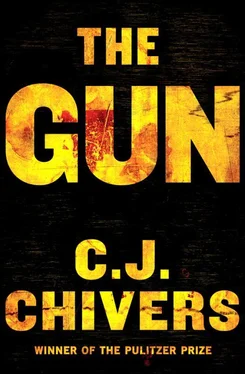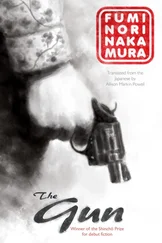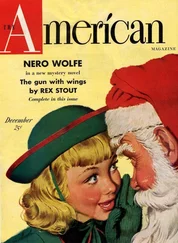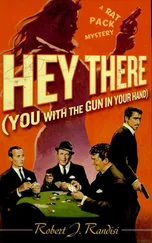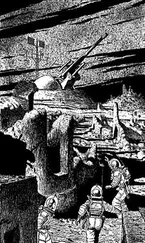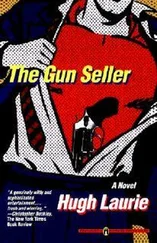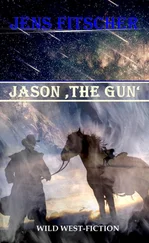Captain Rogers might have made a similar presentation without the money; his attraction to the gun predated the payments. And the British military might have settled on the Gatling as a service arm without his efforts—Gatling guns had outperformed any competitor in several tests. But Dr. Gatling and General Love had invested in quite a performance. The British captain reprised the Gatling gun’s history with relish and read aloud the American translation of Captain Litvinoff’s repulsion of the Yomud charge two years before near Khiva (he even repeated the American mistake, calling the attacking horsemen “Yonoods”). He described Captain Litvinoff walking through the scattered collection of the dead horsemen at dawn, and then he reached a conclusion almost fantastic. “Mark, too, the immediate moral effect produced by this automatic manslayer,” he said. “Its very snarl hushed the war cries of the savage foe. It caused the Yonoods to reel in the saddle and wheel their fiery steeds back once more in the desert; all, that is, who did not bite the dust. I cannot fancy that they returned for wounded men. I cannot fancy that there were any to take away.” 48
The officers were skeptical. In the period for comments and questions after Captain Rogers finished, several officers weighed in against him. “It seems to me that Captain Rogers has somewhat exaggerated the importance of this weapon,” said Captain J. F. Owen, of the British army. “The question for us seems to be, are the advantages of the Gatling such as to counterbalance the disadvantages of taking extra impediments into the field?” 49
The following summer, the outcome of another distant battle hinted at a possible answer. In 1875, a group of Native American tribes left the reservations the government had designated for them in the western territories along the Rocky Mountains, and tensions between the American government and the region’s native populations soared. President Grant issued an ultimatum: Return to the reservations by the New Year, he said, or be considered an enemy force. Several tribes formed a coalition under a spiritual leader, Sitting Bull, and defied the president’s demand. In spring 1876, a large American contingent set out to subdue the refusing tribes. The United States Seventh Cavalry Regiment, under the command of Lieutenant Colonel George A. Custer, was among the units assigned.
On June 25, after several weeks in the field, Colonel Custer’s column came upon an Indian encampment on the Rosebud River in territory now part of the state of Montana. Thinking the encampment was small and vulnerable, the colonel decided to attack from two sides. He ordered Major Marcus A. Reno, his senior subordinate, to advance on the camp with three cavalry companies from the south. Colonel Custer planned to swing round to the north with five more companies and trap the Indians between his forces. Two other elements, including his logistics train, were given supporting roles. Major Reno began his advance but quickly discovered the native camp was not as small as he had believed, and occupied by a large number of Sioux and Cheyenne warriors. The divided American cavalry was no match. Major Reno withdrew under fire and fell back into the protection of cottonwoods and undergrowth, where the cavalrymen dismounted and fought from the ground. Colonel Custer’s assessment of the size and readiness of the native force had been wrong. He had come upon the camp of Sitting Bull and much of the defiant native coalition, which had many more warriors than the United States Army’s scouts in the field had detected in the weeks before the campaign. Major Reno’s command soon found its position among the cottonwoods untenable; the troops retreated farther, scrambling across the river and leaving behind their dead and more than a dozen of their unwounded fellow soldiers. They dashed pell-mell to the comparative safety of a hilltop. There, to their great fortune, they were met by one of the other detachments of American soldiers. These combined American forces began to dig in, anticipating a large Indian attack. The Indians’ attention, however, had been diverted from the major’s weakened command. It had turned to Colonel Custer.
The regimental commander’s detachment, with slightly more than two hundred cavalrymen, had continued unknowingly toward the river camp. It was quickly enveloped. From their hilltop, Major Reno’s men heard some of the resulting ferocity, including the booms of volley fire during the brief time Colonel Custer’s group managed to fight as a unit and resist. Caught by the Indians in unfamiliar terrain and out of the reach of reinforcements, the soldiers were pinned down, then overrun. It was a highly unusual event. The Indians had been elusive. Combat with them was usually swift and fleeting. In this case, however, a small American contingent had collided with the indigenous warriors during a brief period when they were massed. The battle was over in an hour or less. Every man in the colonel’s command was killed. The victorious Cheyenne and Sioux stripped many of the dead soldiers of their clothes and mutilated and scalped corpses. Precisely what happened between the moment when Major Reno’s detachment galloped away and the time when the last man in Colonel Custer’s contingent fell has never been fully known; no cavalrymen survived to tell. But the disposition of the dead soldiers, discovered when another American unit came upon them the next day, and the available Indian accounts, indicated that Colonel Custer’s group made a wall with the carcasses of dead horses, to little effect, and tried to fight off an Indian charge by the old tactic of volleyed rifle fire. Rifles were not enough. The charge broke the lines. Pandemonium followed, with panicked soldiers dropping weapons and scattering on foot, only to be hacked down by pursuing horsemen.
Colonel Custer, young and intense, had been a public personality. His defeat ignited controversy and an investigation. The investigation found many grounds for criticism of the colonel’s decisions, among them that he had been offered Gatling guns, but had left them behind as he rode off to campaign. Thinking they would slow his movement, he opted to plunge into the Indian territory with cavalry armed with single-shot Model 1873 Springfield rifles, and not any rapid-fire arms. The army had recently issued the Springfields; their slower rate of fire was seen as a means to reduce ammunition consumption in distant territories, where resupply was slow and difficult. Colonel Custer fit the old model of officer who rejected the value of machine-gun fire. His position had merit: The Indians’ superior speed and mobility made it difficult for American units to bring firepower to bear on them, and his Gatlings would have been pulled along on carriages, no doubt slowing his advance as he reconnoitered territory. But at his command, the American government’s plans to bring its material superiority against its enemies were turned upside down. Instead of being able to concentrate fire against a concentrated Indian force, densely packed and in the open, Colonel Custer’s soldiers were armed with rifles designed to help preserve their bullets. Red Horse, a surviving Indian chief, was surprised by the Americans’ weakness. The Sioux, he said, drove Colonel Custer’s isolated cavalrymen:
…into confusion; these soldiers became foolish, many throwing away their guns and raising their hands “Sioux, pity us; take us prisoners.” The Sioux did not take a single soldier prisoner, but killed all of them; none were alive for even a few minutes. Those different soldiers discharged their guns but little. I took a gun and two belts off two dead soldiers; out of one belt, two cartridges were gone; out of the other five. 50
No one can say with certitude how the battle might have gone if Colonel Custer had arrived for the fight with rapid-fire weapons. Historians argue both sides, some taking his position. 51If Colonel Custer had brought his Gatlings, he might not have reached Sitting Bull’s encampment that day. But Colonel Henry J. Hunt, the former chief of artillery for the Army of the Potomac, excoriated Custer posthumously for failing to bring the weapons that he had been issued. The Gatlings, he said, would have kept the Sioux and the Cheyenne attackers at bay.
Читать дальше
